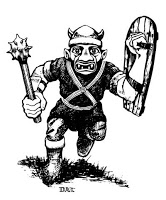And if there’s no real difference between them, why have different species of humanoid in the first place
One way to give them that real difference would be to distinguish them by geography. I could envision a campaign where, say, there are humanoids all over the place, but where you go determines what sort of humanoids you find. This could be done in the Flanaess; the hobgoblins of the Great Kingdom, the orcs of Iuz and the Bandit Kingdoms, goblins as the scourge of the Sheldomar Valley, etc. That would give some nice flavor in terms of distinguishing one area from another, as well as providing for a means of tipping off players that something’s Not Quite Right (“Those were kobolds! There shouldn’t be a kobold within a thousand miles of here
Another way to regionalize your humanoids is to give them some real distinguishing characteristics or abilities that differ by geography. If you just have to have your orcs and goblins shuolder-to-shoulder across the land, you can still break things up and give the players an unexpected twist. Perhaps the orcs in the northern Vesve Forest have honed their archery skills out of necessity from combatting the nearby elves, and now have a +1 to hit with the longbow (which is carried by 75% of them in addition to their regular weapons). The hobgoblins of the Bone March, on the other hand, might have mastered the giant lizards of the region, and formed a force of cavalry mounted on the beasts. Perhaps the goblins of the Pomarj are chaotic evil rather than lawful, and their behavior and tactics will be changed as a result. The kobolds of the Hollow Highlands could get a +1 to hit with their trademark blow guns.
Humanoids don’t have to be as cookie-cutter as they are in many games, or as uniform as they are presented in the Monster Manual. On the other hand, their modifications shouldn’t be capricious (well, *these* gnolls are blue, and they have 8 HD each!). Assigning the characteristics by region helps with both of these goals.










Giving each region a tribe would help too. Make up markings and a little society for each tribe.
For example, the Big Iron Goblins of the Crystalmist Mountains always wear the heaviest armor and the biggest weapons they can get. After a combat they bury their dead and build a cairn of rocks covered with the skulls of the enemies slain. A Big Iron goblin is always buried with some battle gear for use in the afterlife. They believe that to touch the weapons of another is a grave insult, and surrender or defeat among them always involves the giving up of a weapon. For example if there is a dispute before the king about some cows, the loser of the dispute surrenders a weapon to the winner.
I usually go with the "kobolds, goblins, orcs, and hobgoblins are all names for the same thing" approach, and some scholar (much as happens in the real world) has taken the names and used them to label different sorts that he has identified.
Gnolls are a different matter, those guys are part of "beast man" subset. 😀
I love the idea of regionalizing. Its what I've done in my own games (and the setting I'm working on). A lot of the different critters presented in the various Manuals and Folios can be lumped in as variations of one more 'generic' type. Goblins are my 'go to' humanoid in this regard. Hobgoblins are bigger, smarter versions. Bugbears are bigger, stronger versions—then you have things like Tasloi (jungle goblins), Dark Creepers (deep cave goblins—though without a lot of the goofy unfair powers the fiend folio gives them), Gibberlings (deep cave, crazy-feral gobilns), etc. Like Matthew, I see Gnolls as 'Beastmen' and not goblinoids, but they would have regional variations, too—your typical Gnoll/Hyena would appear in African/Mideast type settings, Then you'd have Gnoll/Wolf hybrid types in a European setting and maybe even Gnoll/Bear types in mountains and the like.
Not so much the blue AND 8hd but I've had "Greenskins" been "Blueskins" in some region and Orange in others (far flung places of the world). I don't think humans and elves would be the only ones with different skin colours.